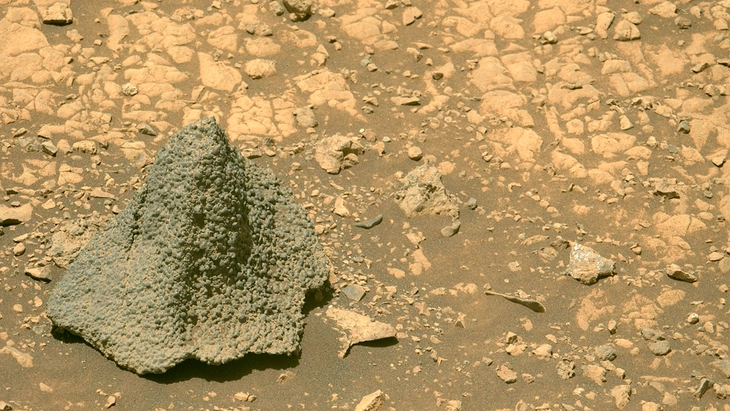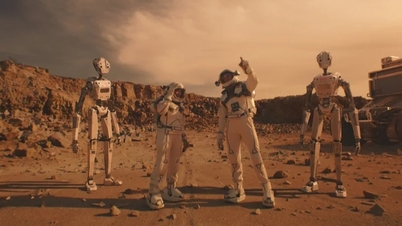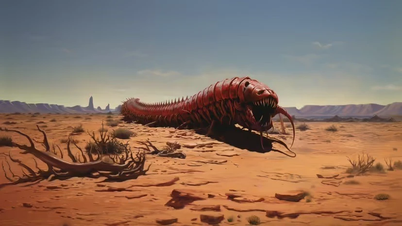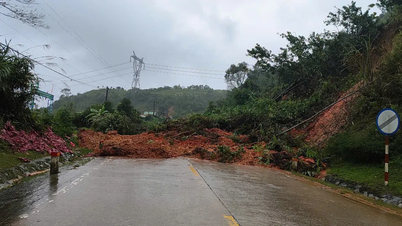
Although just a rock, the Horneflya "helmet" still contributes to helping scientists better understand the geological history of Mars, where wind, water and internal activity have carved the landscape over billions of years - Photo: NASA
The image, taken by the Mastcam-Z camera cluster on the Perseverance rover on August 5, 2025, shows a rock with a sharp peak and a rough surface with countless bumps. From a distance, it is reminiscent of a 17th-century Dutch soldier's helmet, according to Space.
According to David Agle - spokesman for the Perseverance team at the Jet Propulsion Laboratory (JPL, NASA), this rock is called Horneflya. What makes scientists interested is not only its "hat" shape but also the fact that it is almost entirely made up of small spheres called spherules.
On Earth, spherules can form through a variety of processes: groundwater seeping through sedimentary rock, chemical weathering, or volcanic activity. Their abundance on Mars raises the question: Did water once flow through the area, leaving its mark in the rock? The answer will require further analysis from the Perseverance team.
Perseverance has already discovered many other “random works of art”: avocado-shaped rocks, donut-shaped rocks… This is a typical example of the phenomenon of pareidolia, when the human brain assigns familiar shapes to random patterns (like seeing rabbits on the Moon or faces in clouds).
Previously, NASA also released a series of interesting images sent back by the Curiosity rover, including a small rock on Mars that looks exactly like a branch of coral on the seabed of Earth.
Even though it's just a rock, the Horneflya "helmet" helps scientists better understand the geological history of Mars, where wind, water and internal activity have carved the landscape over billions of years.
Perseverance is now continuing its journey on the north rim of Jezero Crater, after tackling the challenging climb to the top of “Lookout Hill” late last year. Each image like this not only satisfies curiosity, but also opens up clues about the past climate and the possibility of life on the red planet.
Source: https://tuoitre.vn/xe-tu-hanh-nasa-phat-hien-mu-bao-hiem-ky-la-tren-sao-hoa-20250814154828024.htm



![[Photo] National Assembly Chairman Tran Thanh Man received a delegation of the Social Democratic Party of Germany](https://vphoto.vietnam.vn/thumb/1200x675/vietnam/resource/IMAGE/2025/10/28/1761652150406_ndo_br_cover-3345-jpg.webp)
![[Photo] Draft documents of the 14th Party Congress reach people at the Commune Cultural Post Offices](https://vphoto.vietnam.vn/thumb/1200x675/vietnam/resource/IMAGE/2025/10/28/1761642182616_du-thao-tai-tinh-hung-yen-4070-5235-jpg.webp)

![[Photo] Flooding on the right side of the gate, entrance to Hue Citadel](https://vphoto.vietnam.vn/thumb/1200x675/vietnam/resource/IMAGE/2025/10/28/1761660788143_ndo_br_gen-h-z7165069467254-74c71c36d0cb396744b678cec80552f0-2-jpg.webp)




























![[Photo] President Luong Cuong attends the 80th Anniversary of the Traditional Day of the Armed Forces of Military Region 3](https://vphoto.vietnam.vn/thumb/1200x675/vietnam/resource/IMAGE/2025/10/28/1761635584312_ndo_br_1-jpg.webp)







































































Comment (0)